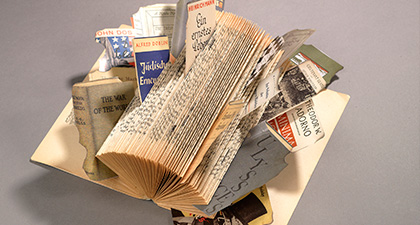The largest annual event in Toronto’s Jewish community calendar, Holocaust Education Week (HEW), presents more than 100 programs, most of them free, in diverse locations across the city – synagogues, libraries, churches, schools and community centres – from Nov. 2 to 9.
The opening night program (Nov. 2, 7:30 p.m. at the Royal Ontario Museum) features Ayelet Waldman, American author of Love and Treasure, a work of historical fiction about the “Hungarian Gold Train.” That was a train the Americans intercepted in Austria in 1945, finding it loaded with gold watches, silver candlesticks, rings, tapestries, furs and other loot the Nazis and their Hungarian collaborators had stolen from Hungary’s Jews.
The ROM is simultaneously hosting Genizot, an exhibition of new work by HEW artist-in-residence Bernice Eisenstein. Contained in an intimate niche in the ROM’s Samuel European Galleries, the exhibition features 10 paintings and a cabinet full of found and made objects that explore the themes of memory, preservation and distillation of experience and meaning. The pieces also explore the theme of collaboration, which is HEW’s unifying theme this season. The exhibit runs until Feb. 8, 2015.
“It’s wonderfully ironic that there are two meanings of ‘collaboration,’” said Eisenstein. “One is to work with a person jointly to achieve something together; the other is to give aid and assistance to an enemy.”
Both types of collaboration are amply explored in multiple programs throughout the week involving both local and visiting presenters. “We’ve been fortunate to have a stellar group of international speakers coming to take part,” said Carson Phillips, assistant director of the hosting Neuberger Holocaust Education Centre. Besides lectures, panel discussions and art exhibitions, scheduled events include film screenings, literary programs, musical and stage performances, survivor testimonies and alternate-language programs in Yiddish, Russian and Hebrew.
Highlights include discussions with HEW educator-in-residence Martin Hagmayr on “Hartheim and the T4 Program,” a euthanasia operation in Austria which resulted in about 30,000 murders; a presentation by author Wendy Lower on her book Hitler’s Furies: German Women in the Nazi Killing Fields; and a performance by the ARC Ensemble of chamber music by “musical collaborator” Jerzy Fitelberg, along with a discussion of related moral issues on individual accountability.
“Kristallnacht Then and Now,” the closing program at Beth Tzedec Congregation (Nov. 9, 7:30 p.m.), features a talk by HEW scholar-in-residence Dr. Doris L. Bergen on less familiar aspects of the infamous “night of broken glass,” along with a display of Holocaust-era treasures of Jewish life in the synagogue’s Reuben and Helene Dennis Museum.
These are only a few examples from HEW’s 50-page program, available at select locations around the GTA; it may also be downloaded from the Neuberger Centre’s website, www.holocaustcentre.com. While most events are free, registration is required and some events require paid tickets.
In terms of participants, HEW 2014 – the 34th annual event since the tradition was founded circa 1980 – may even surpass last year’s collective attendance figures of about 35,000. “We’ve been on an incline for the last five years,” said Phillips, who cites the generous involvement of a robust group of benefactors, partners, volunteers and community organizations behind HEW’s continued growth.
